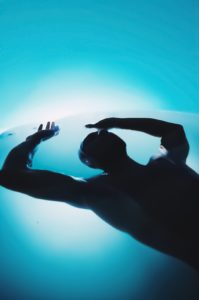What’s the Hype About Sensory Deprivation?
It’s been said there’s an infinite amount to find in the art of doing nothing.
Well, imagine sitting in a pool of salty, skin-temperature water. It’s pitch black, and the meditative music that lulled you into rest has stopped.
(ABOVE: 1,200 pounds of Epsom salt keeps a woman afloat in 11 inches of water at Riviera Spa’s float tank. Courtesy photo)
It’s completely silent.
It’s just you and your thoughts.
This is a sensory deprivation float tank.
It’s not a new concept. In fact, sensory deprivation was somewhat of a sexy field of study in the 1950s and rose in popular awareness in the late 1960s.
Created in 1954 by Dr. John C. Lilly, who used sensory deprivation in combination with mind-altering drugs during his years at the National Institute for Mental Health, the tanks fell out of favor in the 1980s and re-emerged a few years ago in Europe and eventually resurfaced Stateside, too. A Google search shows a few locations peppered around Dallas, including the Riviera Spa in the Knox Street area.
Micah Haynes, manager of the Riviera Spa, said since installing a float tank earlier this year, the demand has caused the Travis Walk center spa to purchase two additional tanks with plans to offer the service 24-hours a day eventually.
Popular among nurses, teachers, athletes, and those who have post-traumatic stress disorder (PTSD), we decided to take a dip to find out about all the hype.

It’s a unique experience.
Hayes said it’s just about the closest on Earth one can get to the feeling of floating in space. Since we haven’t embarked on the new frontier, we’ll state the impression was out of this world.
To be honest, it’s not easy to just float there and relax. Also, it’s a pretty vulnerable place to be. Besides being naked, you’re also going to find yourself stripping down emotionally. Whatever you have going on in your mind is going to come out in that tank, and you’re going to have a long time (an hour) to deal with it. Alone.
However, that’s the point.
An analysis in 1997 of well over 1,000 descriptions of sensory deprivation indicated that more than 90 percent of subjects found it deeply relaxing.
Other studies have shown that floating enhances performance in a variety of athletic and musical tasks that require high levels of concentration and visual-motor coordination. Reseach also has been demonstrated that during resting states the brain repeatedly rehearses newly learned skills and consolidates recently acquired knowledge for long-term storage.
“Our floatation tanks are definitely a form of alternative medicine,” Haynes said, adding that most people will see optimal benefits after three sessions.
The tanks, he said, have been shown to help with physical ailments such as hypertension, rheumatoid arthritis, and chronic pain to mental disorders like anxiety.
“It’s a journey, but it’s hard to pinpoint what anyone goes through because it could be anything,” he added. “Some people feel extremely energized after the service, and then you have some people who are still in that deep, deep level of relaxation.”
We fell into the latter category.
Describing what it felt like to walk out of that tank isn’t easy – it’s comparable to the airiness one might feel after a deep tissue massage and the shakes that come with the flu. It’s like your body and mind are trying really hard to return to the now.
Luckily, the Riviera Spa has a lovely relaxation room where you can enjoy some tea and return to reality (coloring books and journals also are on hand).
“We really do see the potential here for wellness, that’s mentally and physically,” Hayes said. “We believe that when you exercise in treating yourself and cater to what your body needs and your health needs … that is total beauty. That’s about as good as it gets.”
-Stephanie Knefel contributed to this report.






